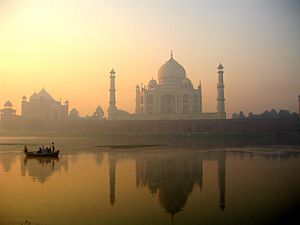The Yamuna (Pron:ˈjʌmʊnə) (Sanskrit: यमुना), sometimes called Jamuna (Hindi: जमुना)', is the largest tributary river of the Ganges (Ganga) in northern India. Originating from the Yamunotri Glacier at a height of 6,387 metres on the south western slopes of Banderpooch peaks in the uppermost region of the Lower Himalayas in Uttarakhand, it travels a total length of 1,376 kilometers (855 mi) and has a drainage system of 366,223 square kilometres (141,399 sq mi), 40.2% of the entire Ganges Basin, before merging with the Ganges at Triveni Sangam, Allahabad, the site for the Kumbha Mela every twelve years.It crosses several states, Uttarakhand, Haryana and Uttar Pradesh, passing by Himachal Pradesh and later Delhi, and meets several of its tributaries on the way, including Tons, its largest and longest tributary in Uttarakhand, Chambal, which has its own large basin, followed by Sindh, the Betwa, and Ken. Most importantly it creates the highly fertile alluvial, Yamuna-Ganges Doab region between itself and the Ganges in the Indo-Gangetic plain. Nearly 57 million people depend on the Yamuna waters. With an annual flow of about 10,000 cubic billion metres (cbm) and usage of 4,400 cbm (of which irrigation constitutes 96 per cent), the river accounts for more than 70 per cent of Delhi’s water supplies. Just like the Ganges, the Yamuna too is highly venerated in Hinduism and worshipped as goddess Yamuna, throughout its course. In Hindu mythology, she is the daughter of Sun God, Surya, and sister of Yama, the God of Death, hence also known as Yami and according to popular legends, bathing in its sacred waters frees one from the torments of death.The water of Yamuna is of "reasonably good quality" through its length from Yamunotri in the Himalayas to Wazirabad in Delhi, about 375 km, where the discharge of waste water through 15 drains between Wazirabad barrage and Okhla barrage renders the river severely polluted after Wazirabad in Delhi. One official describes the river as a "sewage drain" with biochemical oxygen demand (BOD) values ranging from 14 to 28 mg/l and high coliform content. There are three main sources of pollution in the river, namely households and municipal disposal sites, soil erosion resulting from deforestation occurring to make way for agriculture along with resulting chemical wash-off from fertilizers, herbicides, and pesticides and run-off from commercial activity and industrial sites.

Desembocadura entre elevaciones
74.000000
Elevación de origen
3293.000000



Comentar
0